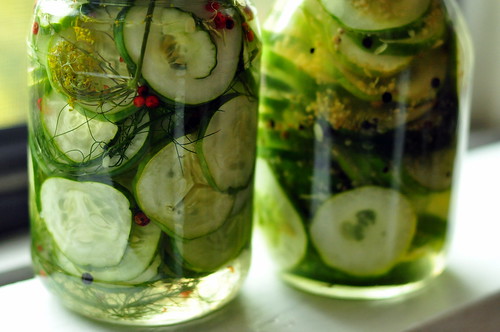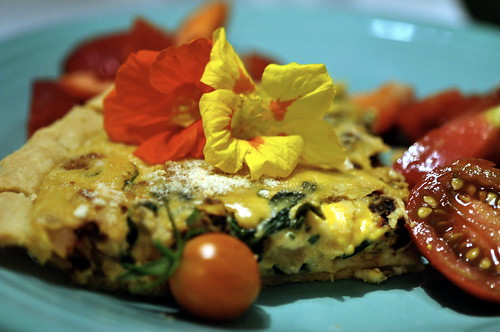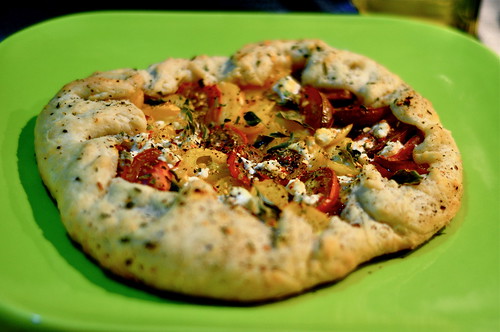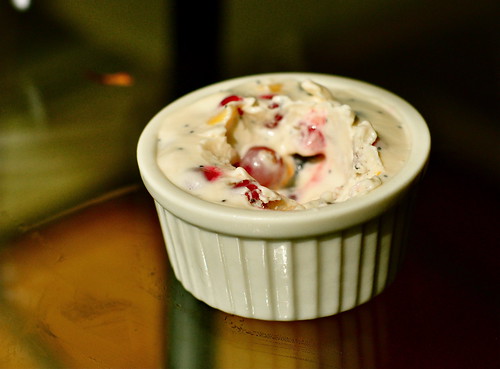Thursday, August 5, 2010
Tip of the Day - Avoiding having to clean the oven
One of the easiest tricks I've learned (the hard way, mind you) is that if I'm cooking something that has a propensity to bubble over, or something cheezy that will ooze right over the edge of the plan - I put a large baking sheet on the rack immediately below whatever is cooking. You can line the baking sheet with parchment paper or foil to make clean-up even easier.
It makes one of the most boring kitchen chores (cleaning the oven) much easier to handle.
Wednesday, August 4, 2010
How long do pantry staples generally last?
So - how do you tell if common pantry staples are fresh?
This list should be of help:
Flour: If it's unopened, it's fresh for about a year, but if it's opened about 6-8 months. I'm not sure if Michigan has the weevil problem Texas had growing up, but it's best to keep flour and other similar products in air tight containers. We've found large food storage containers are especially handy for this - and work better than fancy cannisters.
Sugar: Unopened sugar will last about 2 years. While the sugar doesn't "spoil" exactly, it may take on the flavor of other things that it is stored around, or may absorb moisture and become chunky. For this reason I also suggest keeping it in an air tight container.
Brown sugar: Don't be tempted at the holiday grocery sales to stock up for the year, as brown sugar is only at its peak for about 4 months in the unopened container. If your brown sugar gets hard, you can include a slice of bread or a slice of apple to soften it up.
Confectioners or powdered sugar will be fresh for about 18 months in an unopened package.
Solid shortening or Crisco is good for about 8 months. Make sure that you always use a clean utensil to remove it from the container, as you can inadvertently transfer bacteria or other food matter into the shortening if you are not careful. Once it's opened, it's generally only fresh for about 3 months or so.
Unopened cocoa doesn't ever really go bad, but once it's opened it's generally best to use it within one year.
Spices: Most spices will keep for around 2-4 years if whole, regardless of whether they are opened, as the essential oils are kept in the whole spice. Ground spices, including paprika, red pepper and chili powder will generally last for up to 2 years, depending on the quality of the spice. I can remember fishing out ancient McCormick tins from my great grandmother's cabinets when it came time to use an unusual spice. It's really better to spend a few dollars and get a new container if the spices are quite old. You'll taste the difference.
Unopened baking soda will last about 18 months, and opened about six months. Be very careful how baking soda is stored, as it has a very strong tendency to absorb the odors of other things stored in its vicinity (a prime reason why it's used as an odor remover in cat litter, and recommended that you get an extra box to keep in your refrigerator). I like to keep mine in an airtight glass container rather than the open box in the cabinet.
Baking powder will last about 6 months unopened, but once it's opened it's only fresh for about 3 months. Never dip a wet spoon into it, as it will also absorb moisture which will hasten its spoilage. To test whether it's still fresh - add a teaspon to a third of a cup of hot water. If it foams up and bubbles, it's fresh! If it doesn't, it's time to pitch it. In a pinch and find yourself with stale baking powder? You can make your own! Combine a tablespoon of baking soda with 2 tablespoons of cream of tartar and 1-1/2 tablespoons of cornstarch. It's not quite as effective as store bought baking powder, but it will work.
Cornstarch will last you about 18 months. Again, it's best to keep it in an air-tight container.
Dry pastas will be fresh for about two years if they aren't made with eggs. Once opened, I would say that they're at the point of freshness for up to 9 months. Pasta with eggs will last about the same length of time if unopened, but once opened they're typically only good for one to two months.
Salad dressing will be fresh for just under a year in the cabinet (assuming, of course, that it's unopened). Once opened it's best to use it within 2-3 months.
Honey can stay fresh for up to a year. If it has crystallized on you, don't throw it out - it hasn't gone bad. Put the container in a bowl or measuring cup that is a little larger than the size of your honey container. Fill it with hot water and put in the (very tightly sealed) honey container. In about thirty minutes to an hour, the honey will be a thick liquid again.
Jams, jellies and preserves will last about a year if unopened. For optimal taste, you should use them within six months once opened (and refrigerated).
Peanut butter is best within 6-9 months of purchase if unopened, and about 3 months after it has been opened. Old-fashioned or "natural" peanut butter does not have commercially added stabilizers so the peanut oil will separate and should be stirred back in before using. Be careful about contaminating it with a knife or spoon dipped in a jelly jar first!
Tuesday, August 3, 2010
Tip of the day
Sunday, August 1, 2010
Refrigerator Pickles
We have a community supported agriculture ("CSA") share this summer from Fat Blossom Farm, a farm in Allegan, MI.
It's been nice to pick up our share every week, but we have far more cucumbers than I can ever imagine eating.
I used some dill we had growing in the garden and made up some refrigerator pickles today.
Ingredients
* 1 1/2 cups distilled white vinegar
* 1 tablespoon sea salt
* 1 cup white sugar
* 6 cups sliced cucumbers
Other adds (vary depending on personal taste)
- sliced green bell peppers or sweet onions (such as vidalia or 1046)
- minced garlic (1 heaping tablespoon per quart jar)
- peppercorns (I used a mixture of pink and black tellicherry)
- fresh dill and yellow dill flowers
- mustard seed
- celery seed
I made a couple of quarts tonight - and in each I slightly varied what I included, whole peppercorns, red pepper flakes, garlic, fresh dill and dill flowers, mustard seeds, celery seed, etc.
A word of caution, if you use freshly sliced garlic it may turn bluish or purple. It's still safe to eat, but is due to a chemical reaction in the garlic with the high acidity of the vinegar.
Directions
1. In a medium saucepan over medium heat, bring vinegar, salt and sugar to a boil. Boil until the sugar has dissolved, about 10 minutes.
2. Using a mandoline or a food processor, slice washed cucumbers about 1/4 inch thick. Place the cucumbers in a non-metallic bowl. Pour vinegar, salt and sugar mixture over the cucumbers. Transfer to sterile containers and store in the refrigerator. A word of caution - if you use a plastic container, it will always smell fragrantly of pickles!
Let sit at least 5 days, but will keep for longer than that - assuming you resist the urge to eat them!
Saturday, August 8, 2009
Real men eat quiche
2 (9 inch) shallow pie crusts
2 large handfuls fresh spinach
1 large yellow onion (sweeter varieties such as 1041 or Vidalia are better)
1 tbsp. butter
1 1/2 c. cheese, shredded (I used a variety of cheeses, including white cheddar, parmesan, monterrey jack, etc. - just make sure the final amount is roughly 1 1/2 cups)
3 slices American cheese
1 1/2 oz. soft goat cheese (any variety)
4 eggs, lightly beaten
3/4 c. milk
1 tsp. sea salt
1/4 cup sun dried tomatoes
1 tsp. fresh rosemary
1 tsp. fresh oregano
1 tsp. fresh basil
1 tbsp. bread crumbs per quiche
Nasturtium flowers, as garnish
Roughly chop onion into a large dice. Using a pair of kitchen shears, snip the sundried tomatoes into small pieces. Put butter into a skillet over medium heat. Add onion and caramelize until golden brown, adding 1 tbsp. water if necessary to deglaze the pan. Add two to three large handfuls of spinach. Cook over medium heat, stirring constantly until moisture evaporates and spinach is wilted.
Combine spinach mixture, shredded cheese, goat cheese, crumbled american cheese, eggs, milk, salt, herbs (which you can change to taste), and sundried tomatoes in a large glass bowl. Stir to mix well. Pour half into each pastry shell. Sprinkle bread crumbs over the top of each quiche.
Bake in hot oven (425 degrees) for 15 minutes; lower oven temperature to 350 degrees and bake 20 more minutes or until top is puffy and center quivers when quiche is moved slightly. Let stand 10 minutes before serving.
Can be served warm, room temperature or even chilled.
Wednesday, July 29, 2009
Heirloom tomato and herb galette
For the pastry:
1 1/4 cups all-purpose flour
generous pinch (around 1/4 teaspoon) grey fleur-de-sel (sea salt - you can use regular table salt or plain sea salt if you don't have the grey variety available)
8 tablespoons (1 stick) unsalted butter, cut into
pieces (very cold)
1/4 cup sour cream
1/4 cup very cold water
For the filling:
1/2 pint yellow pear tomatoes
2 or 3 black krim tomatoes
3 tablespoons soft goat cheese (you can use any variety)
1/2 teaspoon grey fleur-de-sel
1/4 teaspoon red pepper flakes, or to taste
1 teaspoon fresh rosemary, finely chopped
1 teaspoon fresh variegated basil, finely chopped
Preheat oven to 400 degrees F.
1. First you need to make the pastry. Using a high speed mixer combine all of the pastry ingredients except for the water and sour cream. Once the mixture makes large clumps, slowly mix in the sour cream and cold water. The dough will resemble peas in size. Be very careful not to overwork the dough. Don't be afraid to leave fairly large (sugar cube size) chunks of butter in the dough as they will give the finished galette a flakier crust. Cover tightly with plastic wrap and refrigerate for 1 hour.
2. Slice tomatoes thinly.
3. Place the dough ball on a sheet of parchment paper on a cookie sheet and roll out to around a 12 inch circle.
4. Take sliced tomatoes and arrange in neat rows or another design of your choosing on top of the dough, leaving about a 2 inch gap around the edge. Obviously this is just an aesthetic step - all that matters is that the tomatoes are very thinly sliced. Sprinkle with fresh herbs and sea salt. Fold the border over the tomatoes, pleating it gently with your fingers as you go. Gently crumble goat cheese on top of the tomatoes. A galette is intended to be rustic looking, so perfection is not necessary. Leave the center of the galette open and uncovered by the dough.
5. Bake until the edges of the crust are flaky and golden brown, about 30 to 35 minutes. Remove from the oven, let stand for 5 minutes, then cut into wedges with a pizza cutter.
The galette can be served hot, warm or at room temperature. The dough can alternatively be used with a wide variety of fruit fillings, and you can freeze the dough for up to two months if well wrapped. If you freeze the dough, defrost the frozen dough in the refrigerator for a day before using.
Saturday, July 11, 2009
Smooth, tangy and cold.
When I was in graduate school, I dated a guy who was from Shreveport, Louisiana. Every once in a while, we'd drive from Waco all the way to Shreveport for this amazing frozen yogurt from a little hole in the wall called "counter culture" that was perfect. It was tangy, and they paired it with fresh berries and fruit. This reminded me somewhat of that perfect marriage of sweet and tartness.
Ingredients:
1 tub of greek style yogurt. I used Trader Joe's Mango Apricot, but any flavor, or just plain would be fine.
1 tsp. poppyseeds
1/2 scant cup of fresh red currants, washed and left whole
1/2 scant cup of small fresh blueberries, washed and left whole
1 tsp. agave syrup (you could also use sugar)
2 tbsp. water
Mix the yogurt, poppyseeds, syrup and water and gently fold in the berries and currants. Spoon into two ramekins and freeze for approximately 3 hours. You can either eat them directly out of the ramekins or unmold them and serve inverted on a plate with a berry coulis.



